Communication, Professionalism, Leadership in Healthcare Report
VerifiedAdded on 2022/11/29
|13
|3520
|447
Report
AI Summary
This report delves into the critical role of communication, professionalism, and interdisciplinary collaboration in healthcare, emphasizing their contribution to effective teamwork, conflict resolution, and the escalation of concerns. It explores leadership and change management principles, including the implementation of patient feedback mechanisms through various methods like online surveys and telephone interviews, and discusses the application of transformational leadership and change models like Lewin's. The report also addresses personal and professional development within the healthcare setting, highlighting the importance of communication skills, teamwork, and the ability to adapt to change. The author reflects on their experiences in a general ward setting, detailing their growth in patient care, teamwork, and leadership, along with discussing the impact of change implementation and the importance of patient feedback in improving healthcare services. The report emphasizes the necessity of effective communication to foster therapeutic relationships, reduce patient anxiety, and improve overall patient outcomes.
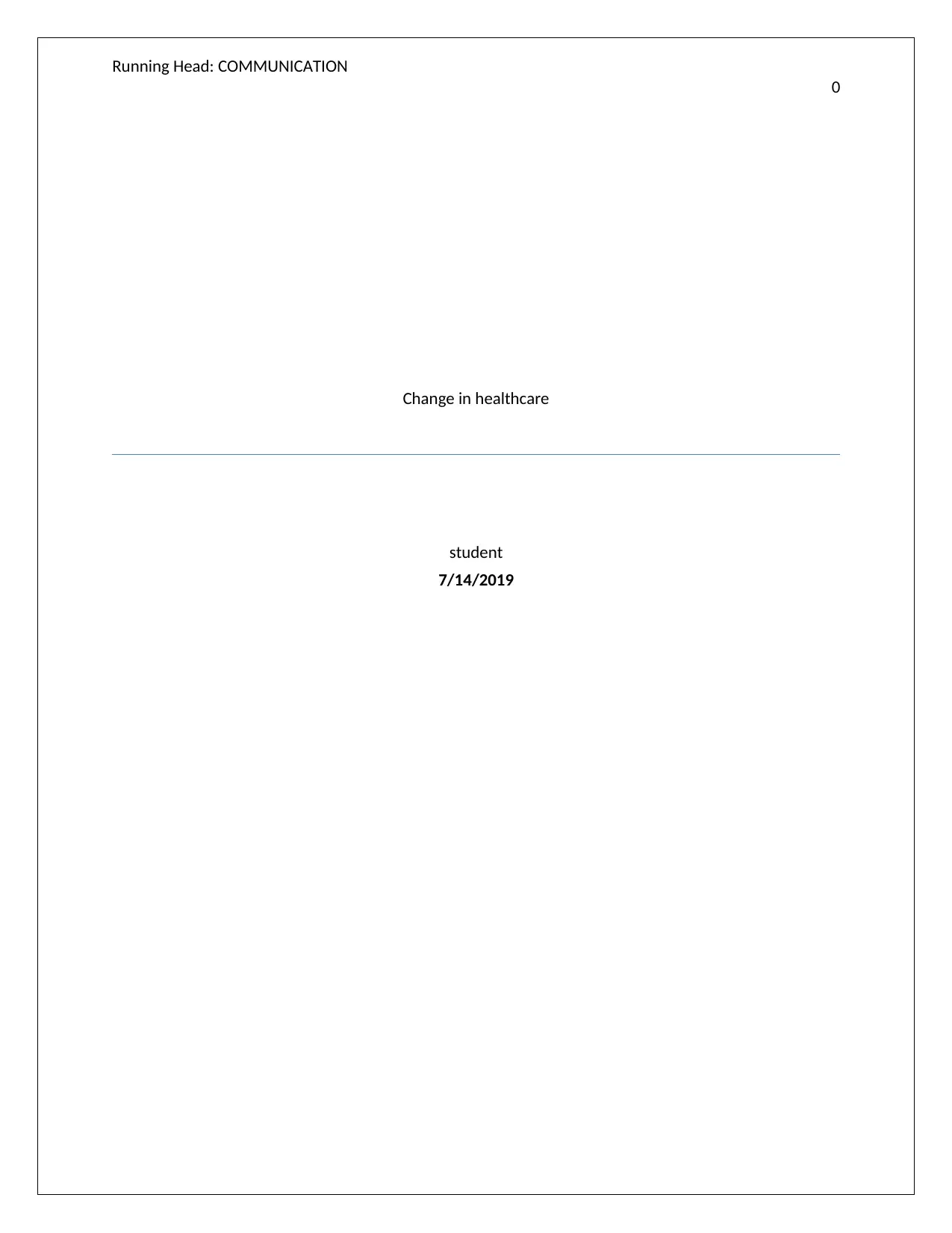
Running Head: COMMUNICATION
0
Change in healthcare
student
7/14/2019
0
Change in healthcare
student
7/14/2019
Paraphrase This Document
Need a fresh take? Get an instant paraphrase of this document with our AI Paraphraser
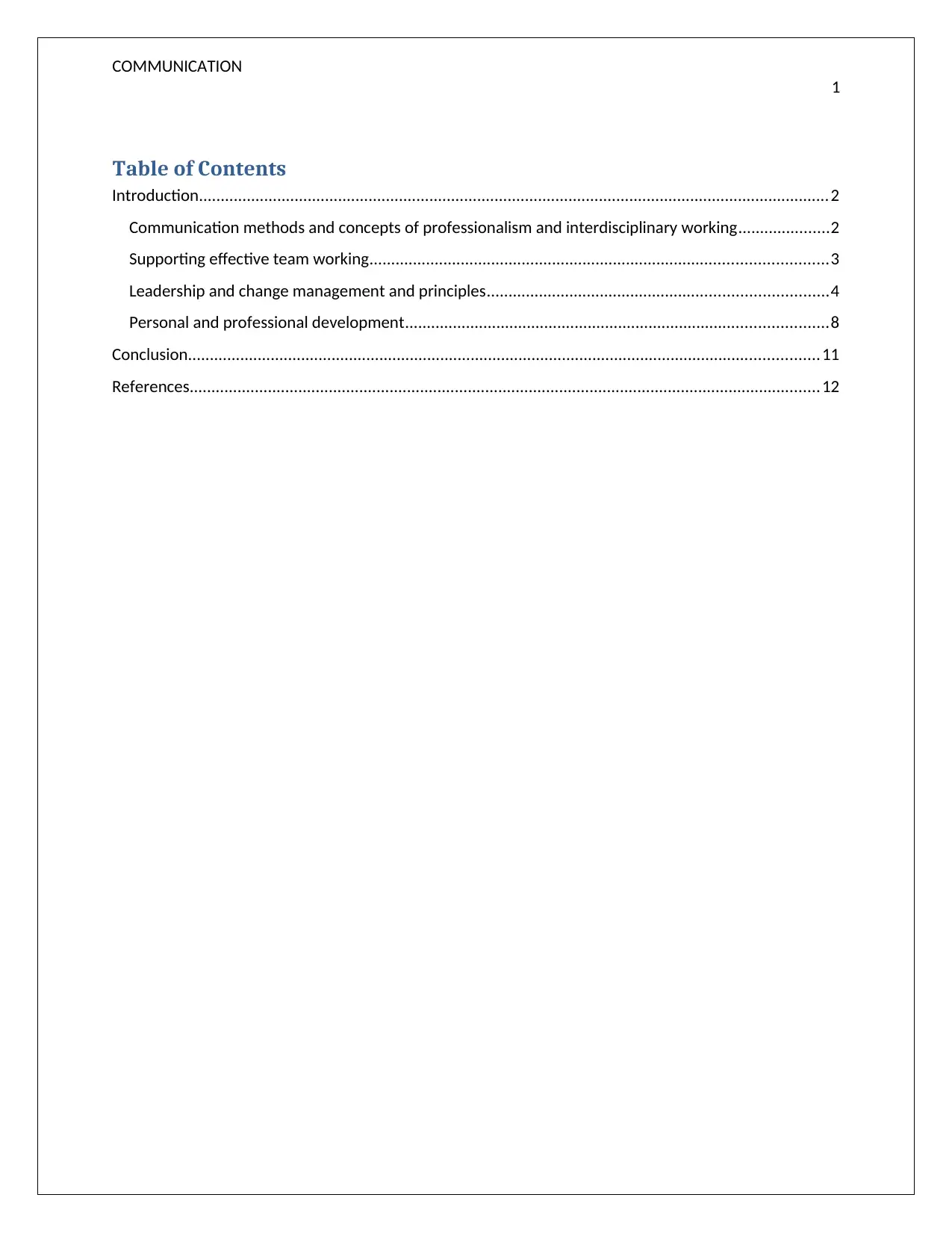
COMMUNICATION
1
Table of Contents
Introduction.................................................................................................................................................2
Communication methods and concepts of professionalism and interdisciplinary working.....................2
Supporting effective team working.........................................................................................................3
Leadership and change management and principles..............................................................................4
Personal and professional development.................................................................................................8
Conclusion.................................................................................................................................................11
References.................................................................................................................................................12
1
Table of Contents
Introduction.................................................................................................................................................2
Communication methods and concepts of professionalism and interdisciplinary working.....................2
Supporting effective team working.........................................................................................................3
Leadership and change management and principles..............................................................................4
Personal and professional development.................................................................................................8
Conclusion.................................................................................................................................................11
References.................................................................................................................................................12
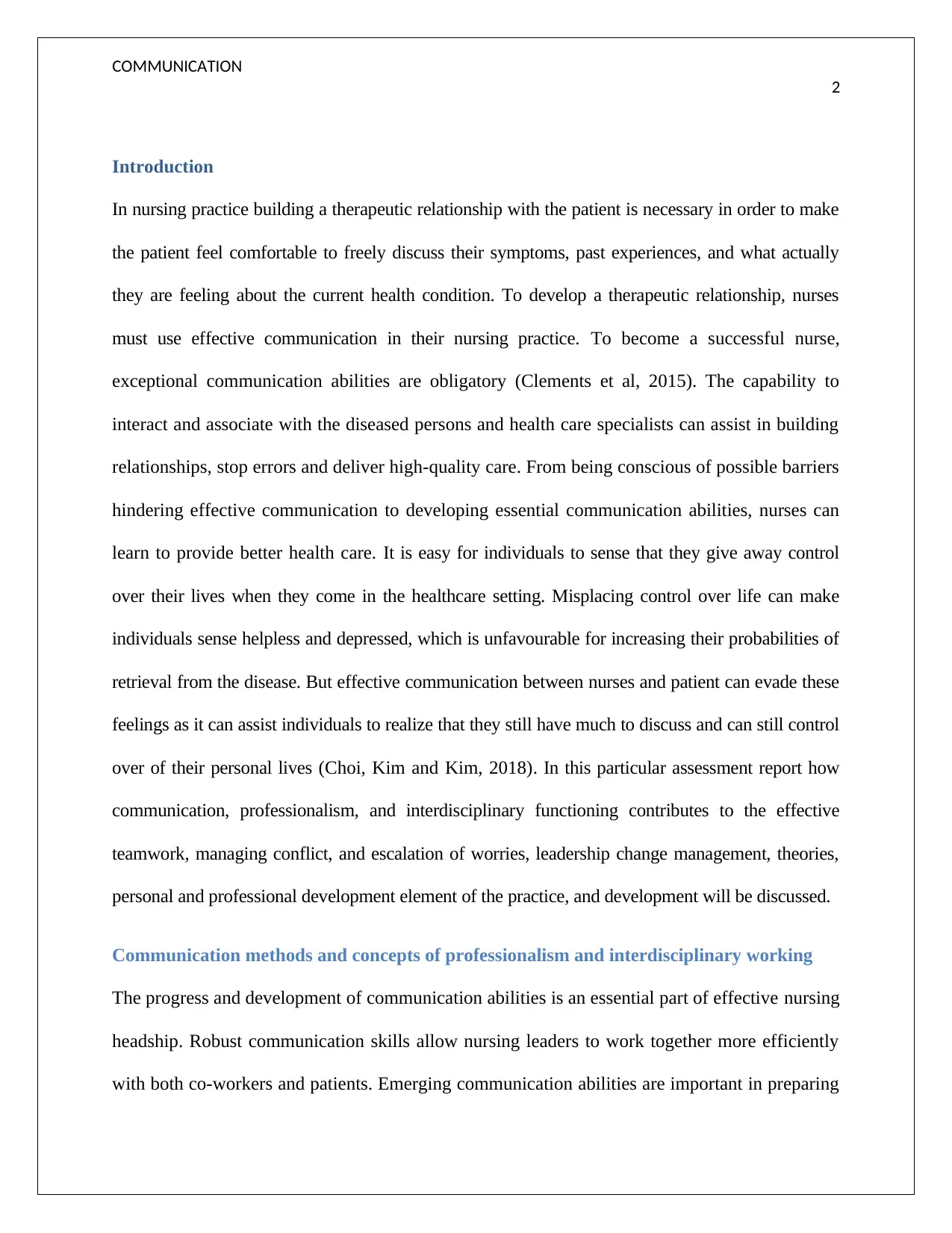
COMMUNICATION
2
Introduction
In nursing practice building a therapeutic relationship with the patient is necessary in order to make
the patient feel comfortable to freely discuss their symptoms, past experiences, and what actually
they are feeling about the current health condition. To develop a therapeutic relationship, nurses
must use effective communication in their nursing practice. To become a successful nurse,
exceptional communication abilities are obligatory (Clements et al, 2015). The capability to
interact and associate with the diseased persons and health care specialists can assist in building
relationships, stop errors and deliver high-quality care. From being conscious of possible barriers
hindering effective communication to developing essential communication abilities, nurses can
learn to provide better health care. It is easy for individuals to sense that they give away control
over their lives when they come in the healthcare setting. Misplacing control over life can make
individuals sense helpless and depressed, which is unfavourable for increasing their probabilities of
retrieval from the disease. But effective communication between nurses and patient can evade these
feelings as it can assist individuals to realize that they still have much to discuss and can still control
over of their personal lives (Choi, Kim and Kim, 2018). In this particular assessment report how
communication, professionalism, and interdisciplinary functioning contributes to the effective
teamwork, managing conflict, and escalation of worries, leadership change management, theories,
personal and professional development element of the practice, and development will be discussed.
Communication methods and concepts of professionalism and interdisciplinary working
The progress and development of communication abilities is an essential part of effective nursing
headship. Robust communication skills allow nursing leaders to work together more efficiently
with both co-workers and patients. Emerging communication abilities are important in preparing
2
Introduction
In nursing practice building a therapeutic relationship with the patient is necessary in order to make
the patient feel comfortable to freely discuss their symptoms, past experiences, and what actually
they are feeling about the current health condition. To develop a therapeutic relationship, nurses
must use effective communication in their nursing practice. To become a successful nurse,
exceptional communication abilities are obligatory (Clements et al, 2015). The capability to
interact and associate with the diseased persons and health care specialists can assist in building
relationships, stop errors and deliver high-quality care. From being conscious of possible barriers
hindering effective communication to developing essential communication abilities, nurses can
learn to provide better health care. It is easy for individuals to sense that they give away control
over their lives when they come in the healthcare setting. Misplacing control over life can make
individuals sense helpless and depressed, which is unfavourable for increasing their probabilities of
retrieval from the disease. But effective communication between nurses and patient can evade these
feelings as it can assist individuals to realize that they still have much to discuss and can still control
over of their personal lives (Choi, Kim and Kim, 2018). In this particular assessment report how
communication, professionalism, and interdisciplinary functioning contributes to the effective
teamwork, managing conflict, and escalation of worries, leadership change management, theories,
personal and professional development element of the practice, and development will be discussed.
Communication methods and concepts of professionalism and interdisciplinary working
The progress and development of communication abilities is an essential part of effective nursing
headship. Robust communication skills allow nursing leaders to work together more efficiently
with both co-workers and patients. Emerging communication abilities are important in preparing
⊘ This is a preview!⊘
Do you want full access?
Subscribe today to unlock all pages.

Trusted by 1+ million students worldwide
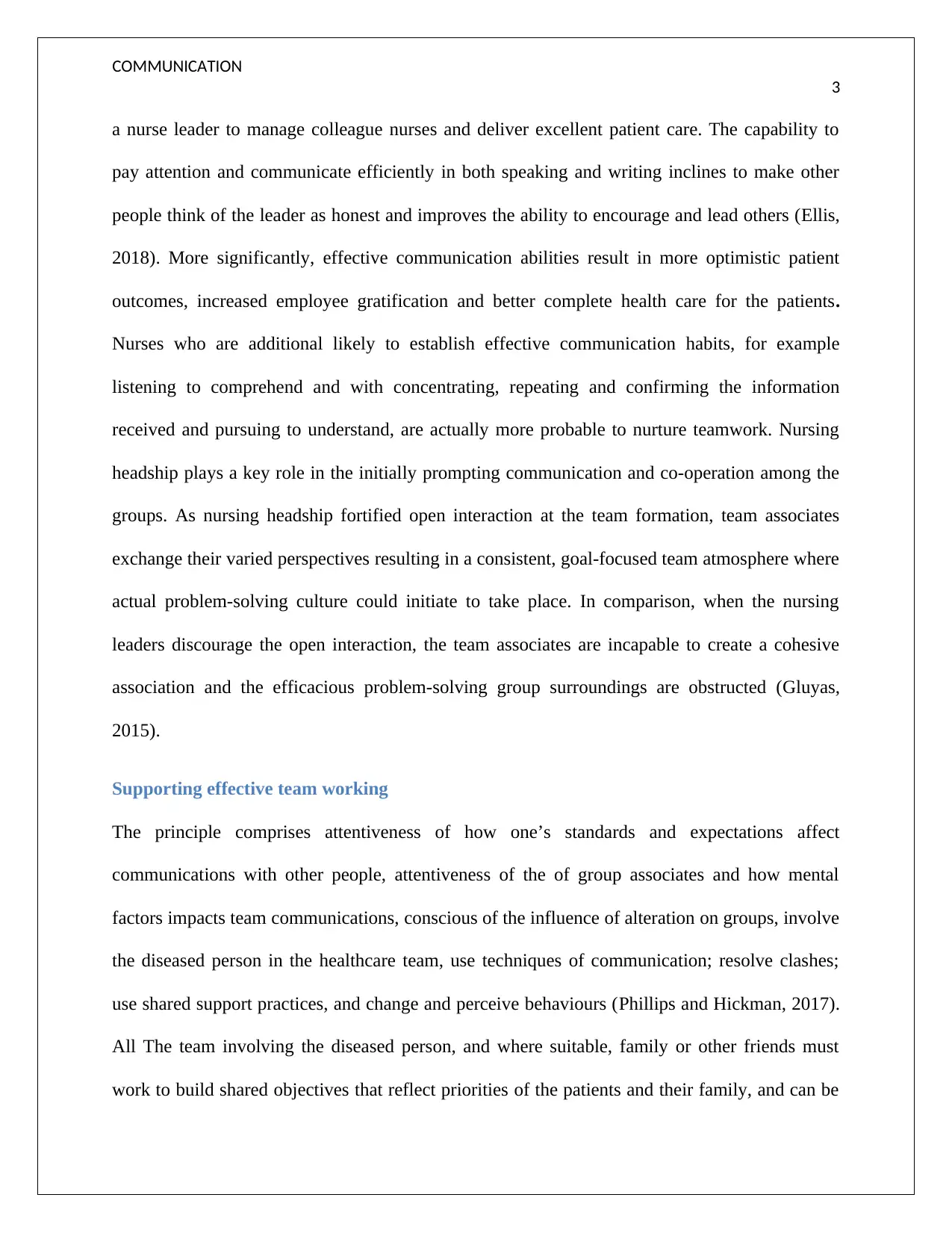
COMMUNICATION
3
a nurse leader to manage colleague nurses and deliver excellent patient care. The capability to
pay attention and communicate efficiently in both speaking and writing inclines to make other
people think of the leader as honest and improves the ability to encourage and lead others (Ellis,
2018). More significantly, effective communication abilities result in more optimistic patient
outcomes, increased employee gratification and better complete health care for the patients.
Nurses who are additional likely to establish effective communication habits, for example
listening to comprehend and with concentrating, repeating and confirming the information
received and pursuing to understand, are actually more probable to nurture teamwork. Nursing
headship plays a key role in the initially prompting communication and co-operation among the
groups. As nursing headship fortified open interaction at the team formation, team associates
exchange their varied perspectives resulting in a consistent, goal-focused team atmosphere where
actual problem-solving culture could initiate to take place. In comparison, when the nursing
leaders discourage the open interaction, the team associates are incapable to create a cohesive
association and the efficacious problem-solving group surroundings are obstructed (Gluyas,
2015).
Supporting effective team working
The principle comprises attentiveness of how one’s standards and expectations affect
communications with other people, attentiveness of the of group associates and how mental
factors impacts team communications, conscious of the influence of alteration on groups, involve
the diseased person in the healthcare team, use techniques of communication; resolve clashes;
use shared support practices, and change and perceive behaviours (Phillips and Hickman, 2017).
All The team involving the diseased person, and where suitable, family or other friends must
work to build shared objectives that reflect priorities of the patients and their family, and can be
3
a nurse leader to manage colleague nurses and deliver excellent patient care. The capability to
pay attention and communicate efficiently in both speaking and writing inclines to make other
people think of the leader as honest and improves the ability to encourage and lead others (Ellis,
2018). More significantly, effective communication abilities result in more optimistic patient
outcomes, increased employee gratification and better complete health care for the patients.
Nurses who are additional likely to establish effective communication habits, for example
listening to comprehend and with concentrating, repeating and confirming the information
received and pursuing to understand, are actually more probable to nurture teamwork. Nursing
headship plays a key role in the initially prompting communication and co-operation among the
groups. As nursing headship fortified open interaction at the team formation, team associates
exchange their varied perspectives resulting in a consistent, goal-focused team atmosphere where
actual problem-solving culture could initiate to take place. In comparison, when the nursing
leaders discourage the open interaction, the team associates are incapable to create a cohesive
association and the efficacious problem-solving group surroundings are obstructed (Gluyas,
2015).
Supporting effective team working
The principle comprises attentiveness of how one’s standards and expectations affect
communications with other people, attentiveness of the of group associates and how mental
factors impacts team communications, conscious of the influence of alteration on groups, involve
the diseased person in the healthcare team, use techniques of communication; resolve clashes;
use shared support practices, and change and perceive behaviours (Phillips and Hickman, 2017).
All The team involving the diseased person, and where suitable, family or other friends must
work to build shared objectives that reflect priorities of the patients and their family, and can be
Paraphrase This Document
Need a fresh take? Get an instant paraphrase of this document with our AI Paraphraser
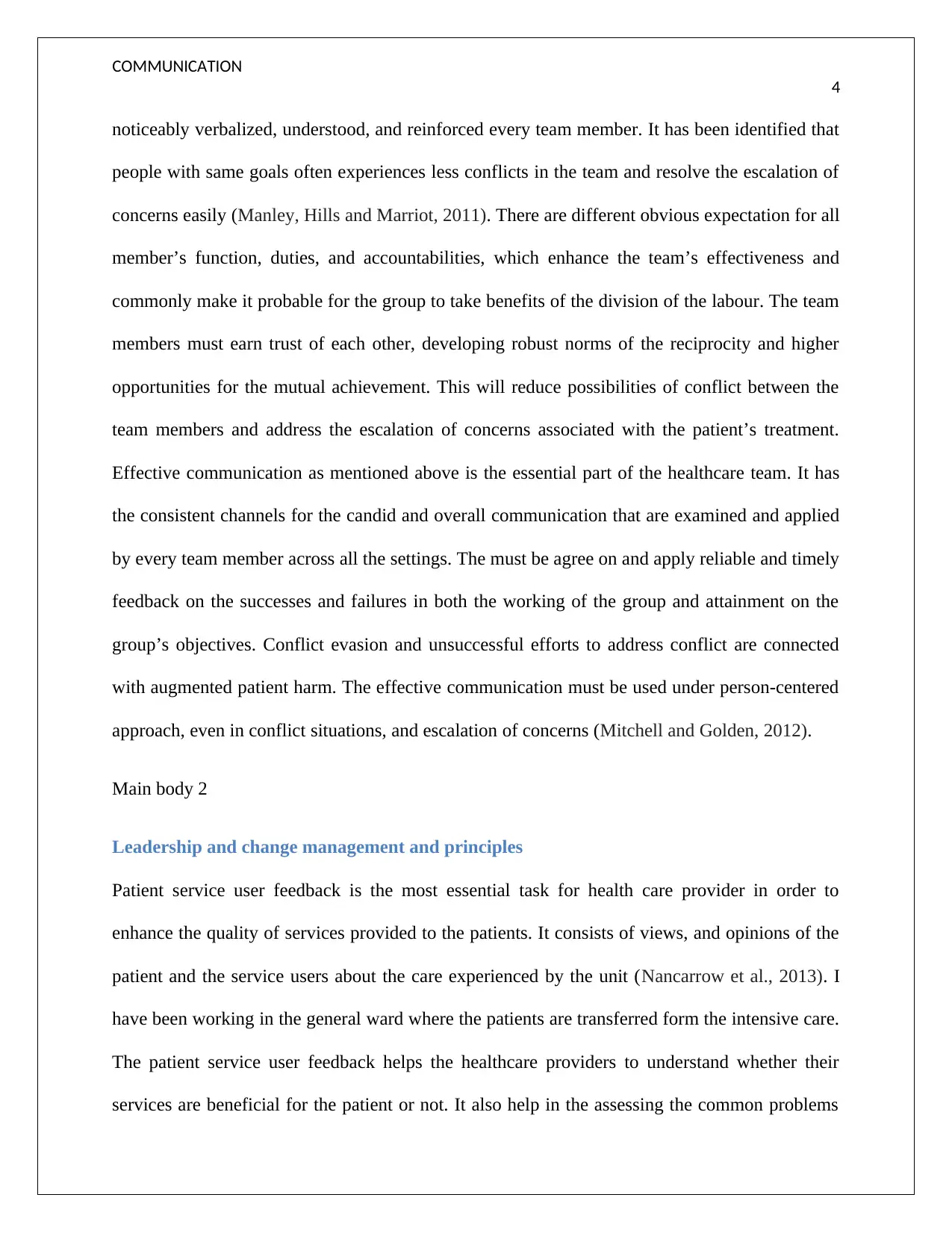
COMMUNICATION
4
noticeably verbalized, understood, and reinforced every team member. It has been identified that
people with same goals often experiences less conflicts in the team and resolve the escalation of
concerns easily (Manley, Hills and Marriot, 2011). There are different obvious expectation for all
member’s function, duties, and accountabilities, which enhance the team’s effectiveness and
commonly make it probable for the group to take benefits of the division of the labour. The team
members must earn trust of each other, developing robust norms of the reciprocity and higher
opportunities for the mutual achievement. This will reduce possibilities of conflict between the
team members and address the escalation of concerns associated with the patient’s treatment.
Effective communication as mentioned above is the essential part of the healthcare team. It has
the consistent channels for the candid and overall communication that are examined and applied
by every team member across all the settings. The must be agree on and apply reliable and timely
feedback on the successes and failures in both the working of the group and attainment on the
group’s objectives. Conflict evasion and unsuccessful efforts to address conflict are connected
with augmented patient harm. The effective communication must be used under person-centered
approach, even in conflict situations, and escalation of concerns (Mitchell and Golden, 2012).
Main body 2
Leadership and change management and principles
Patient service user feedback is the most essential task for health care provider in order to
enhance the quality of services provided to the patients. It consists of views, and opinions of the
patient and the service users about the care experienced by the unit (Nancarrow et al., 2013). I
have been working in the general ward where the patients are transferred form the intensive care.
The patient service user feedback helps the healthcare providers to understand whether their
services are beneficial for the patient or not. It also help in the assessing the common problems
4
noticeably verbalized, understood, and reinforced every team member. It has been identified that
people with same goals often experiences less conflicts in the team and resolve the escalation of
concerns easily (Manley, Hills and Marriot, 2011). There are different obvious expectation for all
member’s function, duties, and accountabilities, which enhance the team’s effectiveness and
commonly make it probable for the group to take benefits of the division of the labour. The team
members must earn trust of each other, developing robust norms of the reciprocity and higher
opportunities for the mutual achievement. This will reduce possibilities of conflict between the
team members and address the escalation of concerns associated with the patient’s treatment.
Effective communication as mentioned above is the essential part of the healthcare team. It has
the consistent channels for the candid and overall communication that are examined and applied
by every team member across all the settings. The must be agree on and apply reliable and timely
feedback on the successes and failures in both the working of the group and attainment on the
group’s objectives. Conflict evasion and unsuccessful efforts to address conflict are connected
with augmented patient harm. The effective communication must be used under person-centered
approach, even in conflict situations, and escalation of concerns (Mitchell and Golden, 2012).
Main body 2
Leadership and change management and principles
Patient service user feedback is the most essential task for health care provider in order to
enhance the quality of services provided to the patients. It consists of views, and opinions of the
patient and the service users about the care experienced by the unit (Nancarrow et al., 2013). I
have been working in the general ward where the patients are transferred form the intensive care.
The patient service user feedback helps the healthcare providers to understand whether their
services are beneficial for the patient or not. It also help in the assessing the common problems
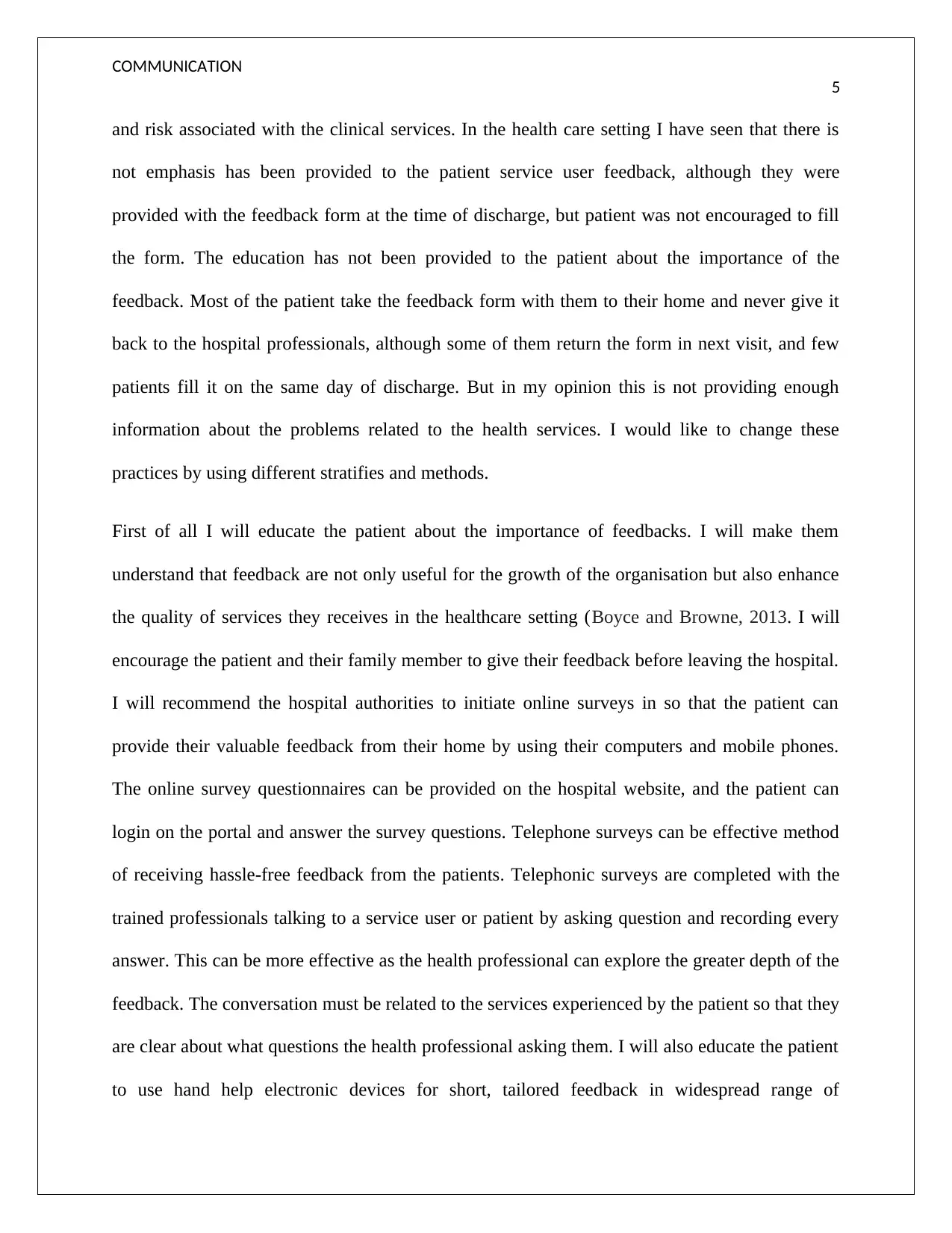
COMMUNICATION
5
and risk associated with the clinical services. In the health care setting I have seen that there is
not emphasis has been provided to the patient service user feedback, although they were
provided with the feedback form at the time of discharge, but patient was not encouraged to fill
the form. The education has not been provided to the patient about the importance of the
feedback. Most of the patient take the feedback form with them to their home and never give it
back to the hospital professionals, although some of them return the form in next visit, and few
patients fill it on the same day of discharge. But in my opinion this is not providing enough
information about the problems related to the health services. I would like to change these
practices by using different stratifies and methods.
First of all I will educate the patient about the importance of feedbacks. I will make them
understand that feedback are not only useful for the growth of the organisation but also enhance
the quality of services they receives in the healthcare setting (Boyce and Browne, 2013. I will
encourage the patient and their family member to give their feedback before leaving the hospital.
I will recommend the hospital authorities to initiate online surveys in so that the patient can
provide their valuable feedback from their home by using their computers and mobile phones.
The online survey questionnaires can be provided on the hospital website, and the patient can
login on the portal and answer the survey questions. Telephone surveys can be effective method
of receiving hassle-free feedback from the patients. Telephonic surveys are completed with the
trained professionals talking to a service user or patient by asking question and recording every
answer. This can be more effective as the health professional can explore the greater depth of the
feedback. The conversation must be related to the services experienced by the patient so that they
are clear about what questions the health professional asking them. I will also educate the patient
to use hand help electronic devices for short, tailored feedback in widespread range of
5
and risk associated with the clinical services. In the health care setting I have seen that there is
not emphasis has been provided to the patient service user feedback, although they were
provided with the feedback form at the time of discharge, but patient was not encouraged to fill
the form. The education has not been provided to the patient about the importance of the
feedback. Most of the patient take the feedback form with them to their home and never give it
back to the hospital professionals, although some of them return the form in next visit, and few
patients fill it on the same day of discharge. But in my opinion this is not providing enough
information about the problems related to the health services. I would like to change these
practices by using different stratifies and methods.
First of all I will educate the patient about the importance of feedbacks. I will make them
understand that feedback are not only useful for the growth of the organisation but also enhance
the quality of services they receives in the healthcare setting (Boyce and Browne, 2013. I will
encourage the patient and their family member to give their feedback before leaving the hospital.
I will recommend the hospital authorities to initiate online surveys in so that the patient can
provide their valuable feedback from their home by using their computers and mobile phones.
The online survey questionnaires can be provided on the hospital website, and the patient can
login on the portal and answer the survey questions. Telephone surveys can be effective method
of receiving hassle-free feedback from the patients. Telephonic surveys are completed with the
trained professionals talking to a service user or patient by asking question and recording every
answer. This can be more effective as the health professional can explore the greater depth of the
feedback. The conversation must be related to the services experienced by the patient so that they
are clear about what questions the health professional asking them. I will also educate the patient
to use hand help electronic devices for short, tailored feedback in widespread range of
⊘ This is a preview!⊘
Do you want full access?
Subscribe today to unlock all pages.

Trusted by 1+ million students worldwide
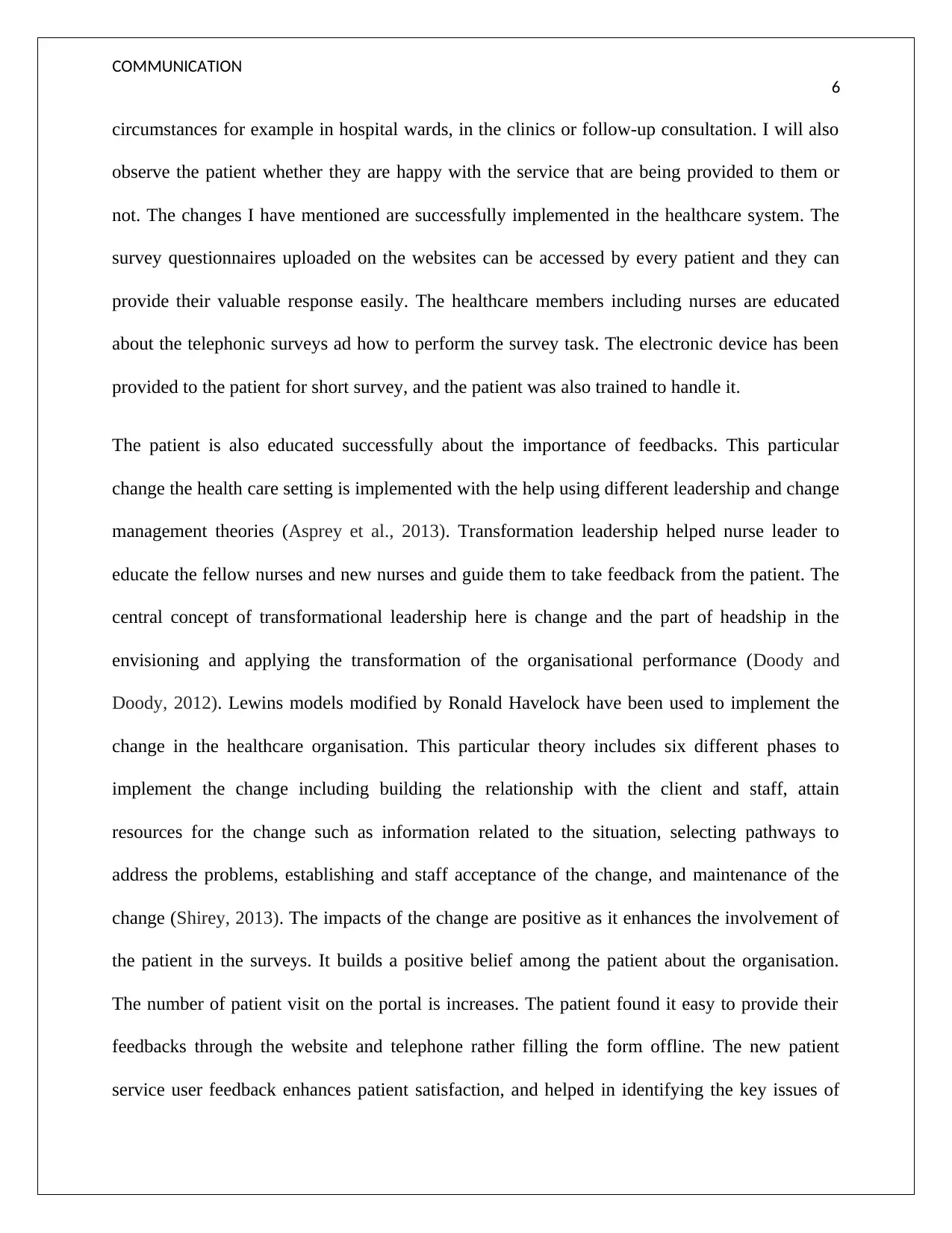
COMMUNICATION
6
circumstances for example in hospital wards, in the clinics or follow-up consultation. I will also
observe the patient whether they are happy with the service that are being provided to them or
not. The changes I have mentioned are successfully implemented in the healthcare system. The
survey questionnaires uploaded on the websites can be accessed by every patient and they can
provide their valuable response easily. The healthcare members including nurses are educated
about the telephonic surveys ad how to perform the survey task. The electronic device has been
provided to the patient for short survey, and the patient was also trained to handle it.
The patient is also educated successfully about the importance of feedbacks. This particular
change the health care setting is implemented with the help using different leadership and change
management theories (Asprey et al., 2013). Transformation leadership helped nurse leader to
educate the fellow nurses and new nurses and guide them to take feedback from the patient. The
central concept of transformational leadership here is change and the part of headship in the
envisioning and applying the transformation of the organisational performance (Doody and
Doody, 2012). Lewins models modified by Ronald Havelock have been used to implement the
change in the healthcare organisation. This particular theory includes six different phases to
implement the change including building the relationship with the client and staff, attain
resources for the change such as information related to the situation, selecting pathways to
address the problems, establishing and staff acceptance of the change, and maintenance of the
change (Shirey, 2013). The impacts of the change are positive as it enhances the involvement of
the patient in the surveys. It builds a positive belief among the patient about the organisation.
The number of patient visit on the portal is increases. The patient found it easy to provide their
feedbacks through the website and telephone rather filling the form offline. The new patient
service user feedback enhances patient satisfaction, and helped in identifying the key issues of
6
circumstances for example in hospital wards, in the clinics or follow-up consultation. I will also
observe the patient whether they are happy with the service that are being provided to them or
not. The changes I have mentioned are successfully implemented in the healthcare system. The
survey questionnaires uploaded on the websites can be accessed by every patient and they can
provide their valuable response easily. The healthcare members including nurses are educated
about the telephonic surveys ad how to perform the survey task. The electronic device has been
provided to the patient for short survey, and the patient was also trained to handle it.
The patient is also educated successfully about the importance of feedbacks. This particular
change the health care setting is implemented with the help using different leadership and change
management theories (Asprey et al., 2013). Transformation leadership helped nurse leader to
educate the fellow nurses and new nurses and guide them to take feedback from the patient. The
central concept of transformational leadership here is change and the part of headship in the
envisioning and applying the transformation of the organisational performance (Doody and
Doody, 2012). Lewins models modified by Ronald Havelock have been used to implement the
change in the healthcare organisation. This particular theory includes six different phases to
implement the change including building the relationship with the client and staff, attain
resources for the change such as information related to the situation, selecting pathways to
address the problems, establishing and staff acceptance of the change, and maintenance of the
change (Shirey, 2013). The impacts of the change are positive as it enhances the involvement of
the patient in the surveys. It builds a positive belief among the patient about the organisation.
The number of patient visit on the portal is increases. The patient found it easy to provide their
feedbacks through the website and telephone rather filling the form offline. The new patient
service user feedback enhances patient satisfaction, and helped in identifying the key issues of
Paraphrase This Document
Need a fresh take? Get an instant paraphrase of this document with our AI Paraphraser
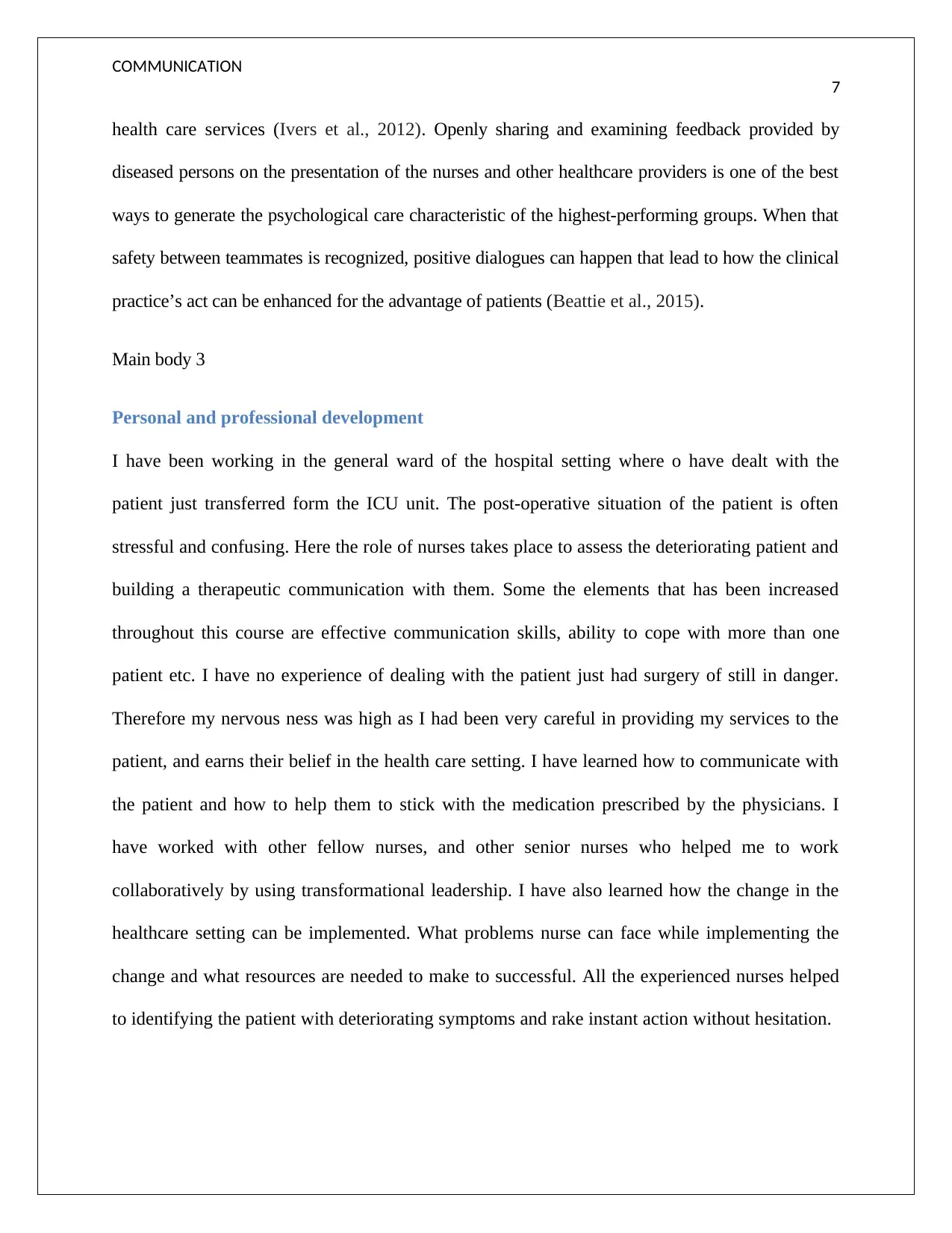
COMMUNICATION
7
health care services (Ivers et al., 2012). Openly sharing and examining feedback provided by
diseased persons on the presentation of the nurses and other healthcare providers is one of the best
ways to generate the psychological care characteristic of the highest-performing groups. When that
safety between teammates is recognized, positive dialogues can happen that lead to how the clinical
practice’s act can be enhanced for the advantage of patients (Beattie et al., 2015).
Main body 3
Personal and professional development
I have been working in the general ward of the hospital setting where o have dealt with the
patient just transferred form the ICU unit. The post-operative situation of the patient is often
stressful and confusing. Here the role of nurses takes place to assess the deteriorating patient and
building a therapeutic communication with them. Some the elements that has been increased
throughout this course are effective communication skills, ability to cope with more than one
patient etc. I have no experience of dealing with the patient just had surgery of still in danger.
Therefore my nervous ness was high as I had been very careful in providing my services to the
patient, and earns their belief in the health care setting. I have learned how to communicate with
the patient and how to help them to stick with the medication prescribed by the physicians. I
have worked with other fellow nurses, and other senior nurses who helped me to work
collaboratively by using transformational leadership. I have also learned how the change in the
healthcare setting can be implemented. What problems nurse can face while implementing the
change and what resources are needed to make to successful. All the experienced nurses helped
to identifying the patient with deteriorating symptoms and rake instant action without hesitation.
7
health care services (Ivers et al., 2012). Openly sharing and examining feedback provided by
diseased persons on the presentation of the nurses and other healthcare providers is one of the best
ways to generate the psychological care characteristic of the highest-performing groups. When that
safety between teammates is recognized, positive dialogues can happen that lead to how the clinical
practice’s act can be enhanced for the advantage of patients (Beattie et al., 2015).
Main body 3
Personal and professional development
I have been working in the general ward of the hospital setting where o have dealt with the
patient just transferred form the ICU unit. The post-operative situation of the patient is often
stressful and confusing. Here the role of nurses takes place to assess the deteriorating patient and
building a therapeutic communication with them. Some the elements that has been increased
throughout this course are effective communication skills, ability to cope with more than one
patient etc. I have no experience of dealing with the patient just had surgery of still in danger.
Therefore my nervous ness was high as I had been very careful in providing my services to the
patient, and earns their belief in the health care setting. I have learned how to communicate with
the patient and how to help them to stick with the medication prescribed by the physicians. I
have worked with other fellow nurses, and other senior nurses who helped me to work
collaboratively by using transformational leadership. I have also learned how the change in the
healthcare setting can be implemented. What problems nurse can face while implementing the
change and what resources are needed to make to successful. All the experienced nurses helped
to identifying the patient with deteriorating symptoms and rake instant action without hesitation.
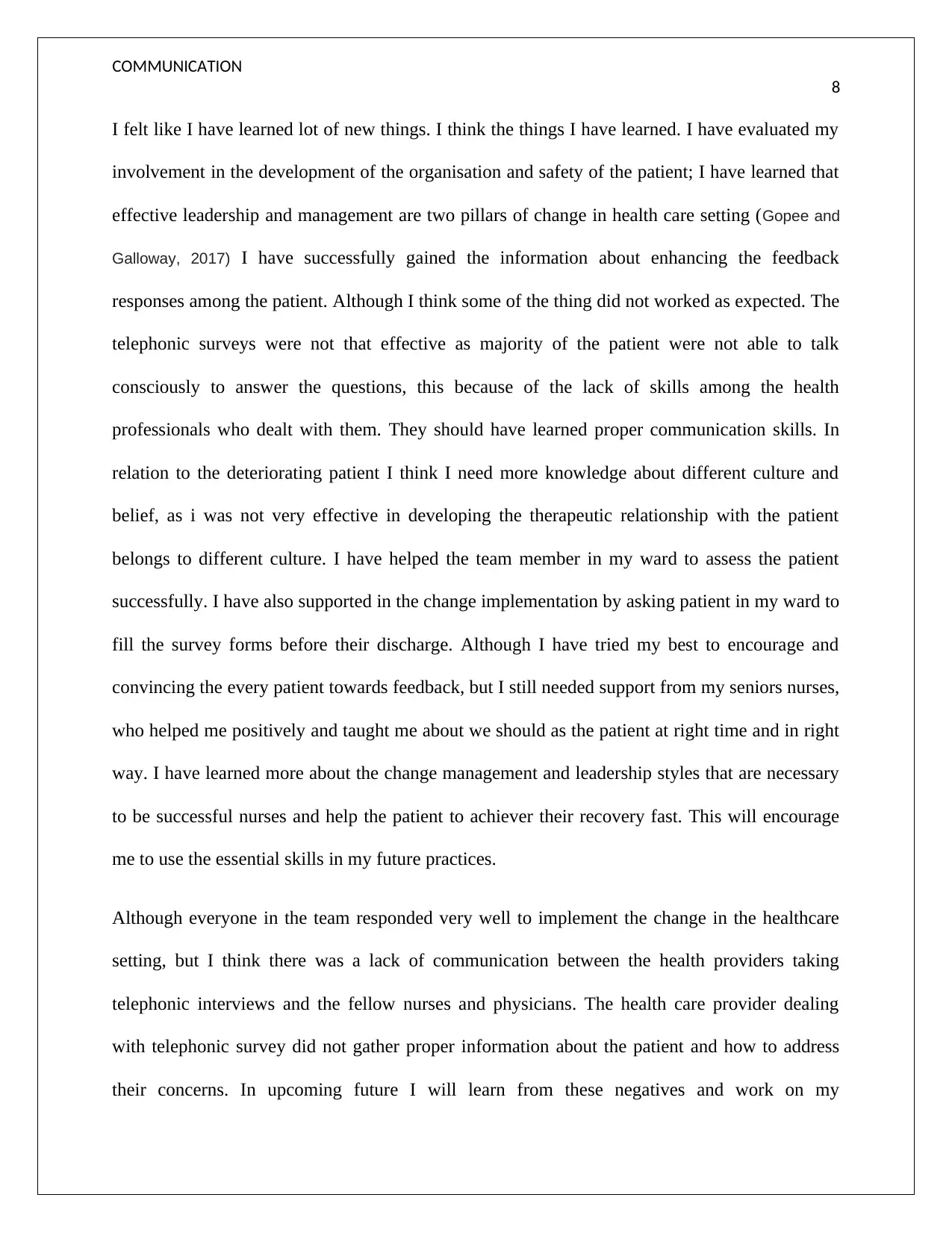
COMMUNICATION
8
I felt like I have learned lot of new things. I think the things I have learned. I have evaluated my
involvement in the development of the organisation and safety of the patient; I have learned that
effective leadership and management are two pillars of change in health care setting (Gopee and
Galloway, 2017) I have successfully gained the information about enhancing the feedback
responses among the patient. Although I think some of the thing did not worked as expected. The
telephonic surveys were not that effective as majority of the patient were not able to talk
consciously to answer the questions, this because of the lack of skills among the health
professionals who dealt with them. They should have learned proper communication skills. In
relation to the deteriorating patient I think I need more knowledge about different culture and
belief, as i was not very effective in developing the therapeutic relationship with the patient
belongs to different culture. I have helped the team member in my ward to assess the patient
successfully. I have also supported in the change implementation by asking patient in my ward to
fill the survey forms before their discharge. Although I have tried my best to encourage and
convincing the every patient towards feedback, but I still needed support from my seniors nurses,
who helped me positively and taught me about we should as the patient at right time and in right
way. I have learned more about the change management and leadership styles that are necessary
to be successful nurses and help the patient to achiever their recovery fast. This will encourage
me to use the essential skills in my future practices.
Although everyone in the team responded very well to implement the change in the healthcare
setting, but I think there was a lack of communication between the health providers taking
telephonic interviews and the fellow nurses and physicians. The health care provider dealing
with telephonic survey did not gather proper information about the patient and how to address
their concerns. In upcoming future I will learn from these negatives and work on my
8
I felt like I have learned lot of new things. I think the things I have learned. I have evaluated my
involvement in the development of the organisation and safety of the patient; I have learned that
effective leadership and management are two pillars of change in health care setting (Gopee and
Galloway, 2017) I have successfully gained the information about enhancing the feedback
responses among the patient. Although I think some of the thing did not worked as expected. The
telephonic surveys were not that effective as majority of the patient were not able to talk
consciously to answer the questions, this because of the lack of skills among the health
professionals who dealt with them. They should have learned proper communication skills. In
relation to the deteriorating patient I think I need more knowledge about different culture and
belief, as i was not very effective in developing the therapeutic relationship with the patient
belongs to different culture. I have helped the team member in my ward to assess the patient
successfully. I have also supported in the change implementation by asking patient in my ward to
fill the survey forms before their discharge. Although I have tried my best to encourage and
convincing the every patient towards feedback, but I still needed support from my seniors nurses,
who helped me positively and taught me about we should as the patient at right time and in right
way. I have learned more about the change management and leadership styles that are necessary
to be successful nurses and help the patient to achiever their recovery fast. This will encourage
me to use the essential skills in my future practices.
Although everyone in the team responded very well to implement the change in the healthcare
setting, but I think there was a lack of communication between the health providers taking
telephonic interviews and the fellow nurses and physicians. The health care provider dealing
with telephonic survey did not gather proper information about the patient and how to address
their concerns. In upcoming future I will learn from these negatives and work on my
⊘ This is a preview!⊘
Do you want full access?
Subscribe today to unlock all pages.

Trusted by 1+ million students worldwide
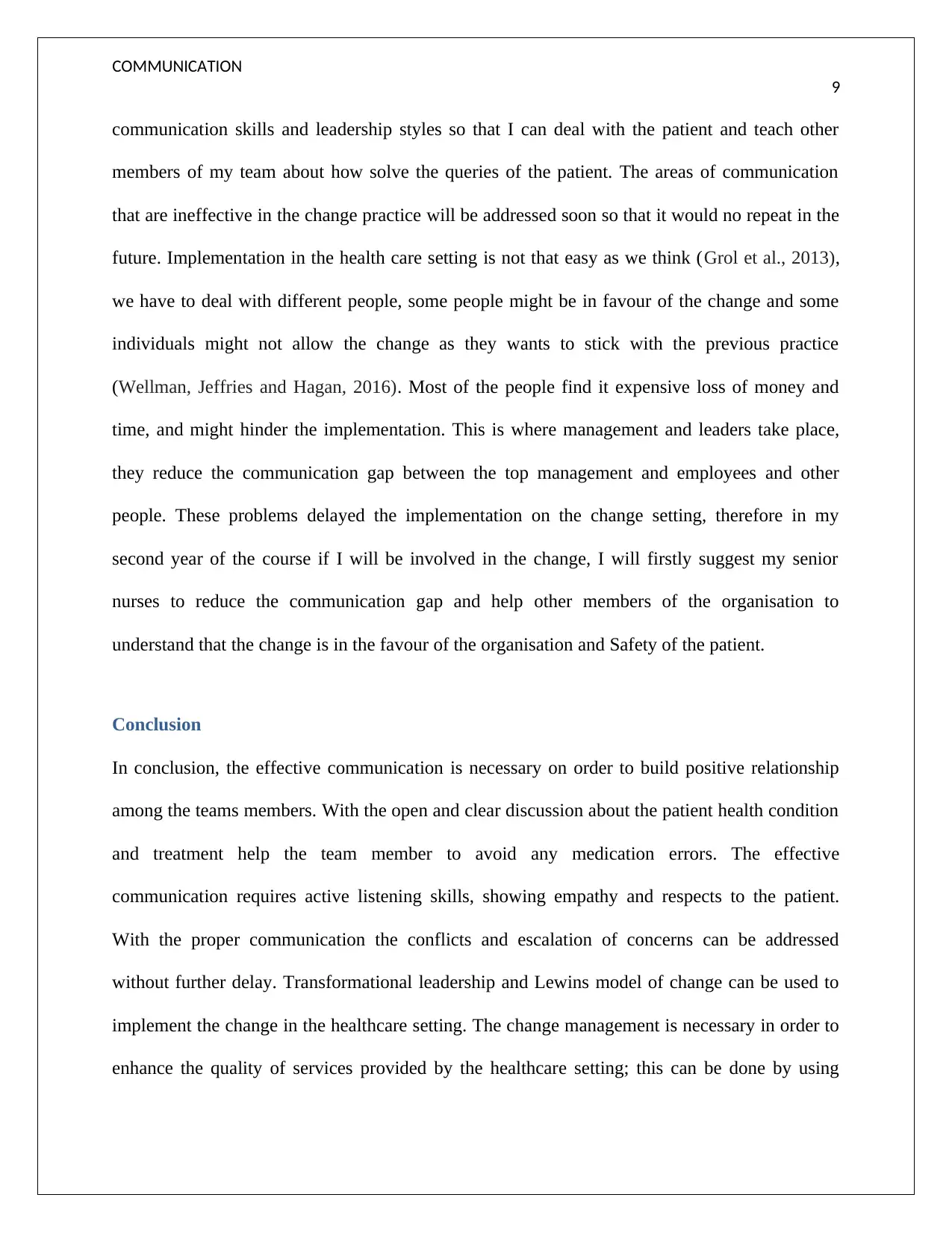
COMMUNICATION
9
communication skills and leadership styles so that I can deal with the patient and teach other
members of my team about how solve the queries of the patient. The areas of communication
that are ineffective in the change practice will be addressed soon so that it would no repeat in the
future. Implementation in the health care setting is not that easy as we think (Grol et al., 2013),
we have to deal with different people, some people might be in favour of the change and some
individuals might not allow the change as they wants to stick with the previous practice
(Wellman, Jeffries and Hagan, 2016). Most of the people find it expensive loss of money and
time, and might hinder the implementation. This is where management and leaders take place,
they reduce the communication gap between the top management and employees and other
people. These problems delayed the implementation on the change setting, therefore in my
second year of the course if I will be involved in the change, I will firstly suggest my senior
nurses to reduce the communication gap and help other members of the organisation to
understand that the change is in the favour of the organisation and Safety of the patient.
Conclusion
In conclusion, the effective communication is necessary on order to build positive relationship
among the teams members. With the open and clear discussion about the patient health condition
and treatment help the team member to avoid any medication errors. The effective
communication requires active listening skills, showing empathy and respects to the patient.
With the proper communication the conflicts and escalation of concerns can be addressed
without further delay. Transformational leadership and Lewins model of change can be used to
implement the change in the healthcare setting. The change management is necessary in order to
enhance the quality of services provided by the healthcare setting; this can be done by using
9
communication skills and leadership styles so that I can deal with the patient and teach other
members of my team about how solve the queries of the patient. The areas of communication
that are ineffective in the change practice will be addressed soon so that it would no repeat in the
future. Implementation in the health care setting is not that easy as we think (Grol et al., 2013),
we have to deal with different people, some people might be in favour of the change and some
individuals might not allow the change as they wants to stick with the previous practice
(Wellman, Jeffries and Hagan, 2016). Most of the people find it expensive loss of money and
time, and might hinder the implementation. This is where management and leaders take place,
they reduce the communication gap between the top management and employees and other
people. These problems delayed the implementation on the change setting, therefore in my
second year of the course if I will be involved in the change, I will firstly suggest my senior
nurses to reduce the communication gap and help other members of the organisation to
understand that the change is in the favour of the organisation and Safety of the patient.
Conclusion
In conclusion, the effective communication is necessary on order to build positive relationship
among the teams members. With the open and clear discussion about the patient health condition
and treatment help the team member to avoid any medication errors. The effective
communication requires active listening skills, showing empathy and respects to the patient.
With the proper communication the conflicts and escalation of concerns can be addressed
without further delay. Transformational leadership and Lewins model of change can be used to
implement the change in the healthcare setting. The change management is necessary in order to
enhance the quality of services provided by the healthcare setting; this can be done by using
Paraphrase This Document
Need a fresh take? Get an instant paraphrase of this document with our AI Paraphraser
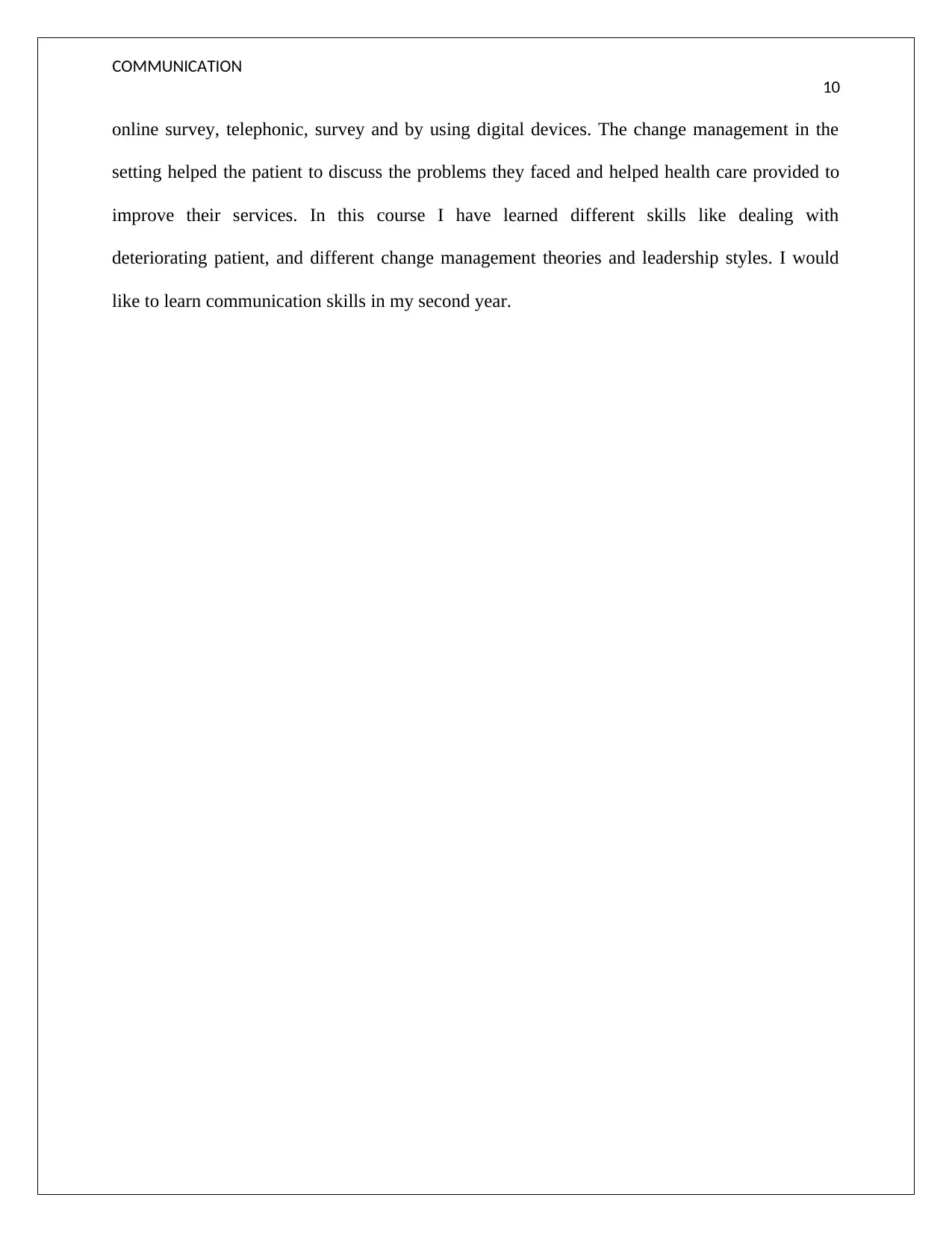
COMMUNICATION
10
online survey, telephonic, survey and by using digital devices. The change management in the
setting helped the patient to discuss the problems they faced and helped health care provided to
improve their services. In this course I have learned different skills like dealing with
deteriorating patient, and different change management theories and leadership styles. I would
like to learn communication skills in my second year.
10
online survey, telephonic, survey and by using digital devices. The change management in the
setting helped the patient to discuss the problems they faced and helped health care provided to
improve their services. In this course I have learned different skills like dealing with
deteriorating patient, and different change management theories and leadership styles. I would
like to learn communication skills in my second year.
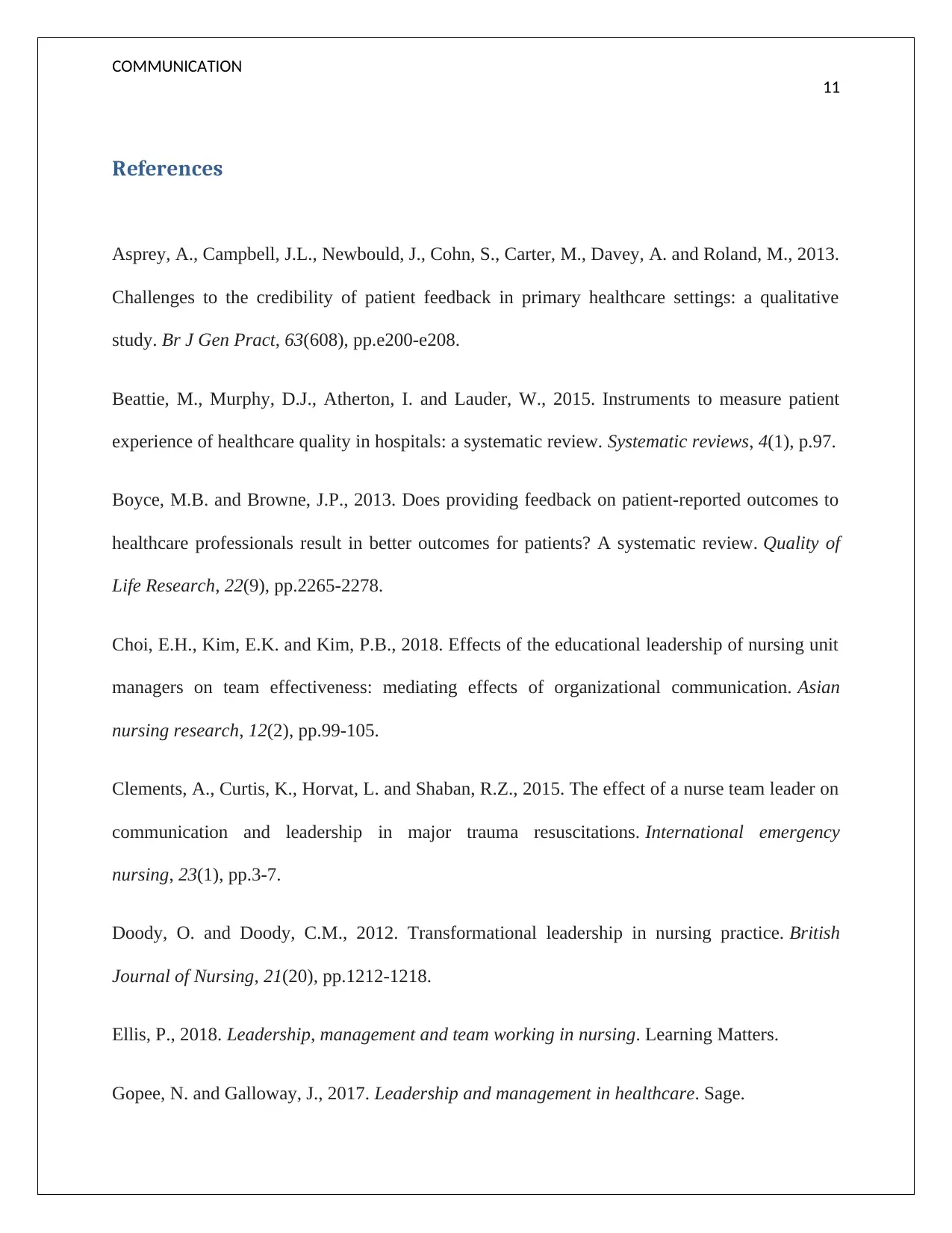
COMMUNICATION
11
References
Asprey, A., Campbell, J.L., Newbould, J., Cohn, S., Carter, M., Davey, A. and Roland, M., 2013.
Challenges to the credibility of patient feedback in primary healthcare settings: a qualitative
study. Br J Gen Pract, 63(608), pp.e200-e208.
Beattie, M., Murphy, D.J., Atherton, I. and Lauder, W., 2015. Instruments to measure patient
experience of healthcare quality in hospitals: a systematic review. Systematic reviews, 4(1), p.97.
Boyce, M.B. and Browne, J.P., 2013. Does providing feedback on patient-reported outcomes to
healthcare professionals result in better outcomes for patients? A systematic review. Quality of
Life Research, 22(9), pp.2265-2278.
Choi, E.H., Kim, E.K. and Kim, P.B., 2018. Effects of the educational leadership of nursing unit
managers on team effectiveness: mediating effects of organizational communication. Asian
nursing research, 12(2), pp.99-105.
Clements, A., Curtis, K., Horvat, L. and Shaban, R.Z., 2015. The effect of a nurse team leader on
communication and leadership in major trauma resuscitations. International emergency
nursing, 23(1), pp.3-7.
Doody, O. and Doody, C.M., 2012. Transformational leadership in nursing practice. British
Journal of Nursing, 21(20), pp.1212-1218.
Ellis, P., 2018. Leadership, management and team working in nursing. Learning Matters.
Gopee, N. and Galloway, J., 2017. Leadership and management in healthcare. Sage.
11
References
Asprey, A., Campbell, J.L., Newbould, J., Cohn, S., Carter, M., Davey, A. and Roland, M., 2013.
Challenges to the credibility of patient feedback in primary healthcare settings: a qualitative
study. Br J Gen Pract, 63(608), pp.e200-e208.
Beattie, M., Murphy, D.J., Atherton, I. and Lauder, W., 2015. Instruments to measure patient
experience of healthcare quality in hospitals: a systematic review. Systematic reviews, 4(1), p.97.
Boyce, M.B. and Browne, J.P., 2013. Does providing feedback on patient-reported outcomes to
healthcare professionals result in better outcomes for patients? A systematic review. Quality of
Life Research, 22(9), pp.2265-2278.
Choi, E.H., Kim, E.K. and Kim, P.B., 2018. Effects of the educational leadership of nursing unit
managers on team effectiveness: mediating effects of organizational communication. Asian
nursing research, 12(2), pp.99-105.
Clements, A., Curtis, K., Horvat, L. and Shaban, R.Z., 2015. The effect of a nurse team leader on
communication and leadership in major trauma resuscitations. International emergency
nursing, 23(1), pp.3-7.
Doody, O. and Doody, C.M., 2012. Transformational leadership in nursing practice. British
Journal of Nursing, 21(20), pp.1212-1218.
Ellis, P., 2018. Leadership, management and team working in nursing. Learning Matters.
Gopee, N. and Galloway, J., 2017. Leadership and management in healthcare. Sage.
⊘ This is a preview!⊘
Do you want full access?
Subscribe today to unlock all pages.

Trusted by 1+ million students worldwide
1 out of 13
Related Documents
Your All-in-One AI-Powered Toolkit for Academic Success.
+13062052269
info@desklib.com
Available 24*7 on WhatsApp / Email
![[object Object]](/_next/static/media/star-bottom.7253800d.svg)
Unlock your academic potential
Copyright © 2020–2025 A2Z Services. All Rights Reserved. Developed and managed by ZUCOL.





